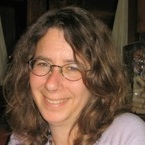


Dr. Feigon received her B.A. from Occidental College and her M.S. and Ph.D. (1982) from the University of California, San Diego where she studied with Dr. David Kearns. Her postdoctoral work was completed at the Massachusetts Institute of Technology, where she was a Damon Runyon-Walter Winchell Cancer Fund Postdoctoral Fellow with Dr. Alexander Rich from 1982-1985. Dr. Feigon joined the UCLA faculty in the Department of Chemistry and Biochemistry in 1985. She is currently Distinguished Professor of Biochemistry and holds the Christopher Foote Term Chair. She is a member of the UCLA-DOE institute of Genomics and Proteomics, the Molecular Biology Institute, and the California Nanosystems Institute. She is a recipient of the Dupont Young Faculty Award, National Science Foundation Presidential Young Investigator Award, Glenn T. Seaborg Research Award, Herbert Newby McCoy Research Award, is a Fellow of the American Association for the Advancement of Science and a Member of the National Academy of Sciences.
Dr. Feigon pioneered the use of NMR to determine structures and dynamics of DNA and RNA. As a graduate student (1976-1982) she used correlation NMR spectroscopy to investigate the interactions of >90 different drugs with DNA and also published the first two dimensional FT NMR spectra of DNA duplexes, demonstrating that NOESY and COSY data could be used reveal structural details. During her postdoctoral work (1982-1985) she used NMR to study the conversion of B-DNA to Z-DNA, correlating B-DNA resonances with Z-DNA resonances in one of the first examples of exchange spectroscopy applied to macromolecules. Dr. Feigon’s early work as a faculty member at UCLA (1985 on) was seminal in defining the conformational variability of DNA. She published the first structures of DNA triplexes, quadruplexes, and aptamers, and her work has provided fundamental insights into DNA A-tract and protein induced bending, cation interactions with DNA, Hoogsteen base pairs, and drug binding to DNA. Her landmark 1992 structural studies of DNA quadruplexes formed by Oxytricha telomere repeats was seminal to the now burgeoning fields of G-quadruplex targeted anticancer and telomerase inhibiting drugs and DNA nanostructures. In the mid-1990s she began to turn her attention to understanding RNA folding and function, including studies of RNA aptamers, ribozymes, and riboswitches, and recognition of RNA by proteins. She solved the first solution structure of a riboswitch (preQ1) (2009) and set the standard for high resolution RNA structures determined by NMR. For all of this work, she has developed new NMR methods and applications for studying nucleic acids structure and dynamics, including assignments and detecting cation interactions. She has combined structural and functional studies of RNA-protein complexes to reveal essential determinants of protein recognition of single stranded and of double stranded RNA by RRMs and dsRBDs, respectively. She has made major contributions to understanding the structure, function, processing, and assembly of H/ACA RNPs, RNase III, and telomerase. Work on these projects as well as other non-coding and riboswitch RNAs is ongoing.
Her most recent work employs hybrid methods of NMR, Xray crystallography, and electron microscopy along with biochemistry to study structure, dynamics, and function of RNA and RNA-protein complexes. For the past decade a major focus of the laboratory has been on telomerase structure and function. Among her seminal achievements in this field was the first structure of a domain of telomerase RNA, a conserved pseudoknot containing a triple helix that is essential for activity (2005) and the structure of a telomerase RNA-protein complex that revealed a conformational change in the RNA required for telomerase assembly and a new protein-RNA recognition motif (2012). In 2013 she published the long awaited structure of a telomerase holoenzyme, determined by electron microscopy, with a model of the RNP catalytic core based on fitting of known NMR and crystal structures.
Dr. Feigon has on-going collaborations with Dr. Kathy Collins (telomerase biochemistry) and Dr. Z. Hong Zhou (electron microscopy) and a long-standing collaboration with Dr. Vladimir Sklenar (NMR methods development). Present and past collaborators include Drs. Michael Stone, Todd Yeates, Shu-ou Shan, Yehuda Tzfati, Tamas Kiss, Guillaume Chanfreau, Christopher Switzer, Duilio Cascio, Robert Clubb, Philippe Bouvet, Michelle Caizergues-Ferrer, Stephan Grzesiek, Wayne Hubbel, Peter Z. Qin, Ite Laird-Offringa, Reid Johnson, Daniel Neuhauser, Robert Griffin, Irvin S.Y. Chen, Jack Szostak, Frank Anet, David Eisenberg, Richard Lehrer, Peter Dervan, Larry Gold, Jacques van Boom, and Andrew H-J Wang.
The Feigon Laboratory
Department of Chemistry and Biochemistry